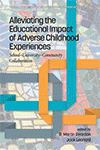
Alleviating the Educational Impact of Adverse Childhood Experiences
School-University-Community Collaboration
Edited by:
R. Martin Reardon, East Carolina University
Jack Leonard, University of Massachusetts Boston (retired)
A volume in the series: Current Perspectives on School/University/Community Research. Editor(s): R. Martin Reardon, East Carolina University. Jack Leonard, University of Massachusetts Boston (retired).
Published 2020
Recent crises—whether policy-induced (e.g., family separation at the Mexico/U.S. border) or natural disaster-related (e.g., hurricanes in Florida and North Carolina and wildfires in California)—have galvanized the attention of the U.S. and international public on the plight of children who endure these traumatic events. The sheer enormity of such wrenching events tend to overshadow the trauma endured by many children whose everyday life circumstances fall short of affording them a safe, stable, and nurturing environment.
At the national level, three rounds of data collection spanning January 2008 through April 2014 constituted the National Survey of Children’s Exposure to Violence (NatSCEV) that—according to Finkelhor, Turner, Shattuck, and Hambly (2013) in reporting on the 2011 round—assessed “a wide range of childhood victimizations” (pp. 614-615). Among many other findings, Finkelor et al. concluded that “overall, 57.7% of the children and youth had experienced or witnessed at least 1 to 5 aggregate exposures (assaults and bullying, sexual victimization, maltreatment by a caregiver, property victimization, or witnessing victimization) in the year before this survey” (p. 619). According to the recent re-visiting of NatSCEV II by Turner et al. (2017), “almost 1 in 4 children and adolescents ages 5-15 in the United States lived in family environments with only modest levels of safety, stability, and nurturance, while about 1 in 15 had consistently low levels across multiple domains” (p. 8).
Adverse childhood events (ACEs) have both immediate and long-term impacts on children’s health and well-being (Banyard, Hambly, & Grych, 2017; Bowen, Jarrett, Stahl, Forrester, & Valmaggia, 2018; Walker & Walsh, 2015). Children do not shed their entanglement with ACEs at the schoolroom door. To highlight just one study, Jimenez, Wade, Lin, Morrow, & Reichman (2016) conducted a secondary analysis of a national urban birth cohort and found that experiencing ACEs in early childhood was “associated with below-average, teacher-reported academic and literacy skills and [more] behavior problems in kindergarten” (p. 1).
CONTENTS
Introduction. North Carolina Resilience and Learning Project, Katie Rosanbalm, Elizabeth DeKonty, and Sheronda Fleming. Trauma-Informed Partnering, Jack Leonard. Our School Behavioral Health “Y’Alliance”: The Development of a Rural School–Community–University Collaboration Focused on Supporting Children Who Have Experienced Trauma, Travis Lewis, Karen D. Jones, Karen Koch, Kia Glosson, and Karen Harrington. Pedagogy and Adverse Childhood Experiences: A Teacher’s Action-Learning Journey in Mitigating the Impact of Trauma Through Changing Teaching Practice, Michelle Montgomery, Roberto H. Parada, and Brenda Dobia. Systemic School Reform Partnership to Address Adverse Childhood Experiences in Flint, Michigan, Bryan Beverly, Nicole Ellefson, and Brian J. Boggs. River of Emotions: Reflecting on a University–School–Community Partnership to Support Children’s Emotional Processing in a Post-Disaster Context, Carol Mutch, Jason Miles, and Sarah Yates. Increasing Trauma-Informed Practices in a High Poverty Elementary School: A School, University, and Community Partnership, Betty V. DeBoer and Alyssa M. Boardman. Schoolwide Trauma Informed Professional Development: We Can! Building Relationships and Resilience, Armeda Stevenson Wojciak, Jan Powers, and Laura Medberry. An Integrated Approach to Mitigating Adverse Childhood Experiences Through Trauma-Informed Yoga, Lauren Dotson Davis and Rebecca Buchanan. Bridging Education and Neuroscience to Support Transformation in Teaching and Learning: A Design-Based Approach, Alison Wishard Guerra, Shana R. Cohen, Amanda Datnow, Timothy Brown, Terry Jernigan, Matt Doyle, and Alan Daly. Coalescing Streams: Interrupting the Progression of Adversity Through Cross-Sector Mobilization and Systems Alignment, John T. King, Aprille Phillips, Todd Bloomquist, and Peter Buckley. A Research-Practice Partnership Serving Students Experiencing Trauma: Best Practices Revealed by an Investigation of a Dropout Prevention Alternative School, Nicole Ralston, Rebecca Smith, Cara Megan Wright, and Jacqueline Waggoner. Creating Holistic Trauma-Informed Schools: School-Based Health Centers, Sherry Shamblin, Dawn Graham, and Erin Lucas. About the Contributors.
-
Paperback978-1-64802-112-1
Web price: $45.04 (Reg. 52.99)
-
Hardcover978-1-64802-113-8
Web price: $80.74 (Reg. 94.99)
- eBook978-1-64802-114-5

- PSY013000 - PSYCHOLOGY: Emotions
- EDU049000 - EDUCATION: Behavioral Management
- EDU045000 - EDUCATION: COUNSELING: Crisis Management
-
 A Place Called Home
School-University-Community Collaboration and the Immigrant Educational Experience
A Place Called Home
School-University-Community Collaboration and the Immigrant Educational Experience
-
 Innovation and Implementation in Rural Places
School-University-Community Collaboration in Education
Innovation and Implementation in Rural Places
School-University-Community Collaboration in Education
-
 Integrating Digital Technology in Education
School-University-Community Collaboration
Integrating Digital Technology in Education
School-University-Community Collaboration
-
 Learning to Read the World and the Word
School-University-Community Collaboration to Enrich Immigrant Literacy and Teacher Education
Learning to Read the World and the Word
School-University-Community Collaboration to Enrich Immigrant Literacy and Teacher Education
-
 Making a Positive Impact in Rural Places
Change Agency in the Context of School-University-Community Collaboration in Education
Making a Positive Impact in Rural Places
Change Agency in the Context of School-University-Community Collaboration in Education
-
 School-University-Community Collaboration for Civic Education and Engagement in the Democratic Project
School-University-Community Collaboration for Civic Education and Engagement in the Democratic Project
-
 School-University-Community Research in a (Post) COVID-19 World
School-University-Community Research in a (Post) COVID-19 World

